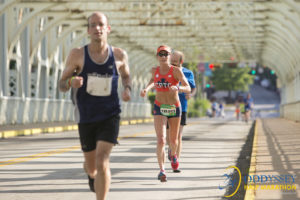 The long run. The cornerstone of marathon training. The weekly run that is essentially “dress rehearsal” for marathon day. It’s the run most runners stress about, and the one that over times builds confidence and endurance fitness. A marathoner cannot be prepared for race day without consistent long runs under their belt, but there’s a lot of opinions, beliefs and falsehoods regarding the long run – especially the magical peak mileage number. It’s important to understand that coaches will have their own reasons for how long they take the long runs, and (hopefully) there’s science-based factors considered. Most non-coaches toss out “20 miles” as the long run distance every marathoner should hit. But I’m going to attempt to shed some light onto the reason for the long run, what mental and physical adaptions occur, the different types of long runs, and why the 20-miler staple is actually not always the correct number. So strap in, cause here we go!
The long run. The cornerstone of marathon training. The weekly run that is essentially “dress rehearsal” for marathon day. It’s the run most runners stress about, and the one that over times builds confidence and endurance fitness. A marathoner cannot be prepared for race day without consistent long runs under their belt, but there’s a lot of opinions, beliefs and falsehoods regarding the long run – especially the magical peak mileage number. It’s important to understand that coaches will have their own reasons for how long they take the long runs, and (hopefully) there’s science-based factors considered. Most non-coaches toss out “20 miles” as the long run distance every marathoner should hit. But I’m going to attempt to shed some light onto the reason for the long run, what mental and physical adaptions occur, the different types of long runs, and why the 20-miler staple is actually not always the correct number. So strap in, cause here we go!
In general, the long run’s purpose is to build endurance fitness, aerobic base, running economy, and prepare the mind for the marathon. Running for hours at a time is physically demanding, but arguably just as challenging to mentally handle. So the big questions and debates for the long run usually come down to pace/effort and distance.
The mileage total should vary per athlete depending on a few things. The natural speed and marathon goal is perhaps the biggest variable. Jack Daniels, arguably the best marathon coach alive, famously recommends capping the long run to 2.5-3 hours across the board. He suggests that a training run lasting beyond that time offers big risk in injury and burnout. Here’s the challenge – depending on the pace of that athlete, a 3-hour run could mean 22 miles or 15 miles. Let’s use three fictional athletes below as an example:
Athlete A is an elite marathoner, with a marathon goal pace of 6:00 minute miles or a 2:37 finish goal. Most long runs should be MGP (Marathon Goal Pace) + :15-60 seconds per mile, so if Athlete A runs a 20-miler at 6:45s, they’d complete the distance in 2:15.
Athlete B is an experience marathoner, with a marathon goal pace of 8:00 minute miles, or a 3:30 finish goal. Most long runs should be MGP (Marathon Goal Pace) + :15-60 seconds per mile, so if Athlete A runs a 20-miler at 8:30s, they’d complete the distance in 2:50.
Athlete C is a marathoner, with a marathon goal pace of 10:18 minute miles, or a 4:30 finish goal. Most long runs should be MGP (Marathon Goal Pace) + :15-60 seconds per mile, so if Athlete A runs a 20-miler at 10:45s, they’d complete the distance in 3:35.
So based on the above, you can see that the 20-miler equals very different stresses on the body. The slower the runner, the more steps and more time one will spend out there, and that equals stress. Athlete C, based on Jack Daniels’ method, should never be running a 20-miler. Instead, it would be recommended that athlete caps the long run to 3 hours, or embraces a double, or other training methods. The mentally hard part: Athlete C would cover less than 17 miles in 3 hours. Most athletes will say they need 20 miles. How can they be ready for a 4:30 marathon finish if their longest long run is 3 hours? The answer is that the long runs don’t stand alone. Runners are going into them with tired legs and additional runs throughout the week. When you add the training up, the taper, the crowd support, ideal weather, etc – the fitness will carry through.
RRCA (Road Runners Club of America) often recommends the 20-30% rule in terms of the long run. The long run distance equals only 20-30% of the athlete’s weekly mileage. This means an athlete running 40-mile weeks should cap the long run to the 8-12 mile range. An athlete running 80-mile weeks finally runs that coveted 20-mile long run. Now, most runners I coach never make it to 80-mile weeks. That’s pretty serious business. But I’d also argue that a decent percentage do run 20-milers. Should they? Well, in my opinion it then goes back to the Daniels theory above. Most runners will not thrive on 80-mile weeks. Though many do run at a pace that allows them to safely clock long runs at or near the 20-mile peak.
Elites like Ryan Hall have been known to clock 26-30 mile long runs. But at his easy pace, he’s still never out there for more than 3 hours. The stress of running for 3 hours versus 5 hours, at an effort that feels 60-70% effort, are two very different stress levels. We also have to consider that someone like Ryan Hall is running 120-140 mile weeks. So for him a 26-30 mile run isn’t a crazy percent of his weekly mileage. It’s unrealistic for us to compare components of our own training without looking at the whole picture.
There are a few different types of long runs, and it’s important to understand them.
Long Slow Distance: The standard long run, where the focus is time on one’s feet to build endurance, practice fueling, and getting acquainted with tired legs. For these runs, pace is usually MGP + :15-60 seconds, or a comfortable/conversational pace. The LSD run can be given by distance or time – for example: run 20 miles or 3 hours – whichever comes first, at an easy effort or MGP + :30 seconds per mile today.
Progressive Long Runs: These long runs are fairly advanced, and start off as a LSD run does. However during the second half, the runner slowly picks up the pace towards MGP. This run teaches the runner how to speed up on tired legs, and break the habit of going out too fast. As one can imagine, this is a higher stress long run than the classic LSD.
Two-a-Days: These long runs are ideal options for runners dealing with an injury or at a pace where a 3 hour runs won’t get them close to a mileage total they feel prepares them for the marathon. Dividing the run between two runs within in 8-10 hours gives the body time to recover and is essentially less stressful than running say 5 hours at once. The second run of the day will obviously happen on tired legs, which is helpful for marathon preparation. However, the two-a-day run doesn’t simulate the marathon, as the marathon will be covered all at once. So there are some clear advantages and disadvantages to this option.
Aside from all of the physical adaptions and stress, most runners feel strongly that they need to 20-miler in their training to feel confident and ready at the starting line. That confidence is incredibly important, and is a good reason why a coach may make an exception to everything above to give that athlete the mental edge. Personally, I know I would have been freaking out if I hadn’t clocked 20-milers leading up to my first marathon. In fact, I capped my long runs to a 23-miler. BUT I also honestly didn’t know what I was doing, didn’t have the resources out there now, or a coach. Knowing what I know now, I’d be willing to accept less than a 20-miler during my marathon training if that’s what was advised. However, even when training for my first marathon, my easy runs were under 8:30 minute miles, so I wasn’t out there much longer than 3:15 on that 23-miler.
It’s tricky to choose what’s appropriate for each athlete. Do we risk injury to give mental edge? Do we prioritize health and accept that the runner may feel unprepared because their long runs never got close to that magical 20-miler? It’s super challenging to hear a runner give me their laundry list as to why they need 20-milers (or longer) when they are typically finishing in the 4:45-5:30 marathon window. Science screams that I need to put my foot down, but that athlete is screaming the opposite. It’s like walking a tightrope. At the end of the day, I usually take it case by case, but I usually side with science, being conservative, and instead doing other things to promote mental edge and confidence for that marathoner.

 On May 15th I ran my first solo marathon since Boston 2015. My goal was simple: lock in a BQ. While I felt pretty confident I’d complete a 3:15-3:30 marathon, a whole lot can happen in the course of 26.2 miles. Plus, this marathon was a short two weeks since my “A” race for 2016, the Broad Street Run.
On May 15th I ran my first solo marathon since Boston 2015. My goal was simple: lock in a BQ. While I felt pretty confident I’d complete a 3:15-3:30 marathon, a whole lot can happen in the course of 26.2 miles. Plus, this marathon was a short two weeks since my “A” race for 2016, the Broad Street Run.




